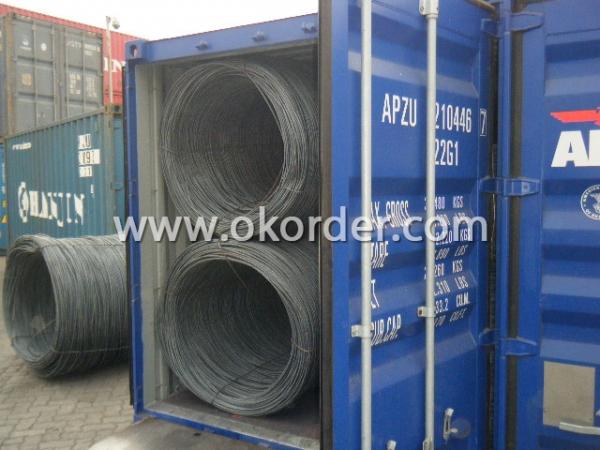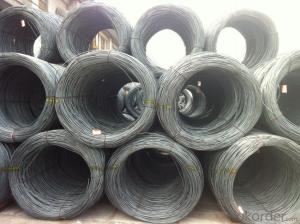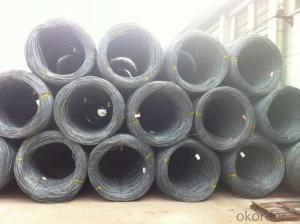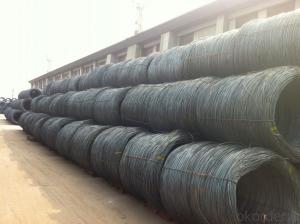High Quality Hot Rolled Wire Rod Carbon Steel
- Loading Port:
- Tianjin
- Payment Terms:
- TT OR LC
- Min Order Qty:
- 20 m.t.
- Supply Capability:
- 2000 m.t./month
OKorder Service Pledge
OKorder Financial Service
You Might Also Like
Product Description:
OKorder is offering Carbon Steel Wire Rod at great prices with worldwide shipping. Our supplier is a world-class manufacturer of steel, with our products utilized the world over. OKorder annually supplies products to European, North American and Asian markets. We provide quotations within 24 hours of receiving an inquiry and guarantee competitive prices.
Product Applications:
Carbon Steel Wire Rod are ideal for structural applications and are widely used in the construction of buildings and bridges, and the manufacturing, petrochemical, and transportation industries.After hot-rolled the products shaped into coil and delivery as finished product, including round, square, rectangular, hexagonal and so on. Since most of the products are round, it is generally called wire rod. Carbon steel wire rod is widely used in construction and manufacturing. Carbon steel wire rod is mainly used for reinforcement of reinforced concrete and welded structure or reprocessed (roberts , nail, etc.) materials, especially used to produce wire drawing, welding electrode, nails, spring, electronic, precise machinery parts and so on.
Product Advantages:
OKorder's Carbon Steel Wire Rod are durable, strong, and resist corrosion.
Main Product Features:
· Premium quality
· Prompt delivery & seaworthy packing (30 days after receiving deposit)
· Corrosion resistance
· Can be recycled and reused
· Mill test certification
· Professional Service
· Competitive pricing
Product Specifications:
Chemical Composition:
Please kindly find our chemistry of our material based on SAE1008B as below for your information
| Trademark | Rank | Chemical composition (quality score) % | ||||
| C | Si | Mn | S | P | ||
| ≤ | ≤ | ≤ | ||||
| Q195 | 0.06-0.12 | 0.30 | 0.25 | 0.050 | 0.045 | |
| Q235 | A | 0.14-0.22 | 0.30 | 0.30-0.65 | 0.050 | 0.045 |
| Q235 | B | 0.12-0.20 | 0.30 | 0.30-0.70 | 0.045 | 0.045 |
Packaging & Delivery of Wire Rod
Packaging Detail: products are packed in coil and then shipped by container or bulk vessel
Each coil weight: 2-3MT
Delivery Detail: within 45 days after received deposit or LC.
Label: to be specified by customer, generally, each bundle has 1-2 labels
Trade terms: CFR, CIF
Note:
1. Our products are produced according to national standard (GB), if not, supply according to national standards (GB) or agreement as customer required.
2. Other Grade and Standard carbon steel wire rod we can supply:
Grade: H08A, 30MnSi, 62B-82B
Standard: AISI, BS, JIS, DIN
The Minimum Order Quantity of these products is high, and need to be confirmed.
3. We can not only supply carbon steel wire rod; if you need anything about building materials, please contact us.
4. Please send us your detail specifications when inquire. We will reply to you as soon as possible. We sincerely hope we can establish a long stable business relationship.
FAQ:
Q1: Why buy Materials & Equipment from OKorder.com?
A1: All products offered byOKorder.com are carefully selected from China's most reliable manufacturing enterprises. Through its ISO certifications, OKorder.com adheres to the highest standards and a commitment to supply chain safety and customer satisfaction.
Q2: How do we guarantee the quality of our products?
A2: We have established an advanced quality management system which conducts strict quality tests at every step, from raw materials to the final product. At the same time, we provide extensive follow-up service assurances as required.
Q3: How soon can we receive the product after purchase?
A3: Within three days of placing an order, we will begin production. The specific shipping date is dependent upon international and government factors, but is typically 7 to 10 workdays.
Image


- Q:How is steel wire rod used in the production of springs for mattresses?
- Steel wire rod is used in the production of springs for mattresses as it serves as the primary material for creating the coiled springs. The wire rod is first straightened and then coiled into the desired spring shape. These springs provide support and elasticity to the mattress, ensuring comfort and proper body alignment for the sleeper.
- Q:How are steel wire rods used in the manufacturing of wire brushes?
- Steel wire rods are an essential component in the manufacturing of wire brushes. These rods serve as the base material from which the bristles of the brush are made. The steel wire rods are first drawn through a series of dies to reduce their diameter and increase their length. This process, known as wire drawing, ensures that the wire is of the desired thickness and strength for brush bristles. Once the wire has been drawn, it is then cut into specific lengths, depending on the size of the brush being manufactured. These cut lengths are then inserted into the brush's base, typically made of wood or plastic, and secured in place using various techniques such as stapling or twisting. The steel wire rods used in wire brushes are usually made from high-quality carbon steel, which provides the necessary durability and flexibility required for effective brushing. Additionally, the wire is often coated with a layer of protective material, such as zinc or brass, to prevent corrosion and enhance its longevity. The bristles made from steel wire rods are widely used in various industries and applications. Wire brushes with steel bristles are commonly used for cleaning, deburring, polishing, and surface preparation tasks. They are particularly effective in removing rust, paint, and other stubborn residues from metal surfaces. The strength and resilience of steel wire bristles make them suitable for heavy-duty cleaning and abrasive tasks. In summary, steel wire rods play a crucial role in the manufacturing of wire brushes by serving as the raw material for the bristles. Through wire drawing, cutting, and securing processes, these rods are transformed into durable and effective bristles that are widely used in various industries for cleaning and surface preparation purposes.
- Q:How are steel wire rods used in the manufacturing of wire baskets for storage and organization?
- Wire baskets for storage and organization rely heavily on steel wire rods. These rods are essential for creating the wire mesh that shapes the basket. To begin with, the steel wire rods undergo a series of processes, including cleaning, straightening, and cutting. These steps ensure the rods are the desired length and free from any impurities. Once prepared, the rods are then passed through a wire-drawing machine. This machine reduces their diameter to the desired size and increases their tensile strength. Afterward, the wire rods are introduced into a wire mesh machine, where they are woven together to create a strong mesh pattern. The size of the mesh can be customized to fit the specific requirements of the wire basket. The resulting mesh is then cut into sheets of the appropriate dimensions. These sheets of wire mesh are shaped and welded together to form the structure of the basket. The steel wire rods provide not only strength and stability but also ensure the basket can withstand the weight of stored items without bending or deforming. Furthermore, the wire rods can be coated or treated with finishes like galvanization or powder coating. This enhances their durability and resistance to corrosion. As a result, the wire baskets can be used in various environments, even damp or corrosive conditions, without losing their functionality or degrading over time. In conclusion, steel wire rods are indispensable in the manufacturing of wire baskets for storage and organization. They serve as the primary material for creating the wire mesh structure. The strength, durability, and customization options offered by steel wire rods make them a crucial component in producing functional and long-lasting wire baskets.
- Q:What are the different types of coatings used on steel wire rod?
- There are various types of coatings used on steel wire rods, each serving a specific purpose and providing unique benefits. Some common types of coatings include: 1. Zinc Coating: Zinc is one of the most widely used coatings for steel wire rods. It provides excellent corrosion resistance, acting as a protective barrier between the steel and the surrounding environment. Zinc coatings can be applied through hot-dip galvanizing or electroplating processes. 2. Polymer Coating: Polymer coatings are often applied to steel wire rods to enhance their durability and resistance to abrasion. These coatings can be made from various types of polymers, such as polyethylene or polypropylene, and are often applied through extrusion processes. 3. Phosphate Coating: Phosphate coatings are used to improve the adhesion between the steel wire rod and subsequent coatings or paints. They provide a rough surface that enhances the bonding ability of other coatings, thereby increasing their effectiveness. 4. Epoxy Coating: Epoxy coatings are commonly used for steel wire rods that will be exposed to harsh environments, such as marine or industrial applications. These coatings offer excellent chemical resistance and durability, protecting the steel from corrosion and other forms of degradation. 5. Chrome Coating: Chrome coatings provide a highly polished and decorative finish to steel wire rods. They are often used in applications where aesthetics are important, such as in the manufacturing of furniture or automotive components. 6. Nickel Coating: Nickel coatings are used to enhance the corrosion resistance of steel wire rods in highly corrosive environments, such as marine or chemical processing applications. Nickel coatings can be applied through electroplating processes. 7. Copper Coating: Copper coatings are applied to steel wire rods to improve their electrical conductivity. They are often used in applications where the wire rod will be used for electrical purposes, such as in wiring systems or electronic devices. It is important to note that the choice of coating for a steel wire rod will depend on the specific application and the desired properties of the finished product. Furthermore, some coatings can be combined or modified to achieve specific performance requirements.
- Q:What are the common applications of low alloy steel wire rod?
- Low alloy steel wire rod has various common applications due to its specific properties and characteristics. Some of the most common applications of low alloy steel wire rod include: 1. Construction industry: Low alloy steel wire rod is widely used in the construction industry for reinforcing concrete structures. It is commonly used to manufacture welded wire mesh, which is used to reinforce concrete slabs, walls, and foundations. The high strength and durability of low alloy steel wire rod make it an ideal choice for withstanding heavy loads and preventing structural failure. 2. Automotive industry: Low alloy steel wire rod is extensively used in the automotive industry for manufacturing various components. It is commonly used to produce springs, suspension systems, and other high-stress components that require excellent strength and fatigue resistance. The low alloy steel wire rod's ability to withstand heavy loads and constant stress makes it well-suited for automotive applications. 3. Manufacturing industry: Low alloy steel wire rod is also used in various manufacturing processes. It is commonly employed in the production of fasteners, such as screws, bolts, and nuts, due to its high tensile strength. Additionally, low alloy steel wire rod is used for manufacturing wire ropes, cables, and other high-strength wire products that require durability and resistance to corrosion. 4. Engineering industry: Low alloy steel wire rod finds applications in the engineering industry for fabricating structural components, machinery parts, and equipment. It is often used for manufacturing gears, shafts, and bearings due to its excellent wear resistance and ability to withstand heavy loads. The low alloy steel wire rod's properties make it a reliable choice for critical engineering applications. 5. Electrical industry: Low alloy steel wire rod is used in the electrical industry for manufacturing various electrical conductors and components. It is commonly used to produce overhead power lines, electrical cables, and wires due to its high electrical conductivity and mechanical strength. The low alloy steel wire rod's ability to carry electricity efficiently and its resistance to mechanical stress make it suitable for electrical applications. In summary, low alloy steel wire rod has a wide range of applications in the construction, automotive, manufacturing, engineering, and electrical industries. Its high strength, durability, wear resistance, and electrical conductivity make it a versatile material for various applications that require reliability and performance.
- Q:How is the quality of steel wire rod measured?
- To assess the mechanical properties, chemical composition, and overall performance of steel wire rod, a series of tests and evaluations are conducted. These evaluations determine the quality of the rod based on several key parameters: 1. Tensile Strength: This test measures the rod's ability to withstand stress before breaking or deforming. It indicates its capacity to bear weight and resist tension. 2. Yield Strength: This test determines the stress level at which permanent deformation occurs. It indicates the rod's ability to return to its original shape after being subjected to stress. 3. Elongation: By measuring the percentage increase in length before the rod breaks under tension, this test provides insights into its ductility and ability to elongate without compromising integrity. 4. Hardness: This test assesses the rod's resistance to indentation or scratching, indicating its strength and durability. 5. Chemical Composition: The steel wire rod's composition is analyzed to ensure it meets the required standards. This involves evaluating levels of carbon, manganese, silicon, sulfur, phosphorus, and other alloying elements. 6. Surface Quality: Visual inspection and sometimes microscopic analysis are conducted to detect defects like cracks, scratches, or impurities. A smooth and clean surface is essential for optimal performance. 7. Dimensional Accuracy: The rod's diameter and length are measured to ensure they adhere to specified tolerances. Deviations from the required dimensions can impact the rod's usability in various applications. 8. Microstructure Analysis: This examination involves detailed observation of the rod's internal structure using microscopy. It helps identify abnormalities such as grain size, inclusions, or segregation that may affect its strength and performance. Through these tests and evaluations, manufacturers can ensure that steel wire rod meets the necessary quality standards and is suitable for its intended applications, such as manufacturing wire products, reinforcing materials, or springs.
- Q:What are the different sizes and dimensions available for steel wire rod?
- The sizes and dimensions available for steel wire rods can vary depending on the manufacturer and the specific requirements of the customer. Common sizes range from 5.5mm to 20mm in diameter, with lengths typically ranging from 2,000mm to 6,000mm. However, it is important to note that custom sizes and dimensions can also be produced to meet specific project needs.
- Q:How is steel wire rod used in the production of reinforcement bars?
- Steel wire rod is used in the production of reinforcement bars by being heated and passed through a series of dies to form the desired shape and size. This process, known as hot rolling, helps strengthen the steel wire rod and enhances its ductility, making it suitable for use in reinforcement bars. The reinforcement bars, also known as rebars, are then used to provide strength and support to concrete structures, such as buildings, bridges, and highways, by reinforcing them against tension and bending forces. Overall, steel wire rod plays a vital role in the production of reinforcement bars, ensuring the durability and structural integrity of various construction projects.
- Q:What are the common industry standards for steel wire rod manufacturers?
- The common industry standards for steel wire rod manufacturers typically include specifications related to the chemical composition, mechanical properties, dimensional accuracy, surface quality, and packaging requirements of the wire rods. These standards are set by organizations such as the American Society for Testing and Materials (ASTM), International Organization for Standardization (ISO), and national or regional standards bodies. Compliance with these standards ensures the quality and consistency of steel wire rod products in the market.
- Q:What are the main components of a steel wire rod mill?
- The main components of a steel wire rod mill include a reheating furnace, roughing mill, intermediate mill, finishing mill, cooling bed, and coiling machines. The reheating furnace is used to heat the raw material, which is typically billets or ingots, to a temperature suitable for rolling. This helps in reducing the material's brittleness and improving its plasticity. The roughing mill is responsible for reducing the thickness of the heated material through a series of rolling passes. It consists of multiple stands of rolls that gradually decrease the size of the material. After the roughing mill, the material is passed through the intermediate mill. This mill further reduces the thickness and improves the surface quality of the wire rod. The finishing mill is the final stage of the rolling process. It consists of several stands of rolls that give the wire rod its final dimensions and surface finish. This mill is crucial in achieving the desired mechanical properties and dimensional accuracy of the wire rod. Once the wire rod is rolled to the desired shape and size, it is then transferred to the cooling bed. The cooling bed allows the wire rod to cool down gradually, preventing any deformation or cracking due to the high temperatures from the rolling process. Finally, the coiling machines are used to coil the wire rod into spools or coils, making it easier for transportation and storage. Overall, these main components work together in a steel wire rod mill to transform raw materials into high-quality wire rods that can be used in various industries such as construction, automotive, and manufacturing.
1. Manufacturer Overview |
|
|---|---|
| Location | |
| Year Established | |
| Annual Output Value | |
| Main Markets | |
| Company Certifications | |
2. Manufacturer Certificates |
|
|---|---|
| a) Certification Name | |
| Range | |
| Reference | |
| Validity Period | |
3. Manufacturer Capability |
|
|---|---|
| a)Trade Capacity | |
| Nearest Port | |
| Export Percentage | |
| No.of Employees in Trade Department | |
| Language Spoken: | |
| b)Factory Information | |
| Factory Size: | |
| No. of Production Lines | |
| Contract Manufacturing | |
| Product Price Range | |
Send your message to us
High Quality Hot Rolled Wire Rod Carbon Steel
- Loading Port:
- Tianjin
- Payment Terms:
- TT OR LC
- Min Order Qty:
- 20 m.t.
- Supply Capability:
- 2000 m.t./month
OKorder Service Pledge
OKorder Financial Service
Similar products
New products
Hot products
Related keywords




























